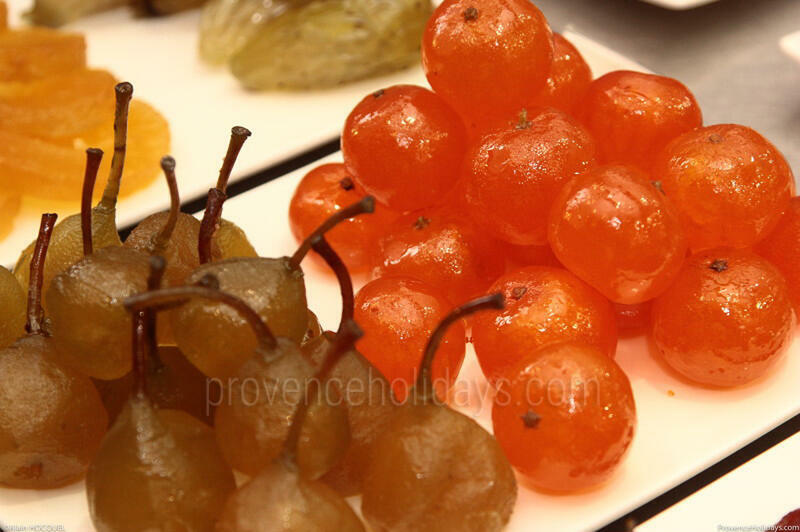Candied Fruits
History
The history of candied fruit is a long quest for pleasure! In ancient times, the Chinese, Persians, Greeks and Egyptians sought ways to preserve fruit in winter. They first used honey. It was during the crusades in the East that Westerners discovered the marvels of fruit jellies, jams and the famous candied fruits. These delicacies were introduced to France in the Middle Ages.
In the Luberon, at that time, they began by making jams, then fruits prepared in honey. In the 14th century, the Aptésiens offered candied fruit to Pope Clement VI, who came on a pilgrimage. He is said to have given the town the title of "confectionery squire".
Since that time, Apt has been recognised as the world capital of candied fruit and, as a result, France is the world's leading producer with 14,000 tonnes generally destined for export. The UK is the world's largest consumer of candied fruit.
Varieties and Flavours
To candy a fruit is to replace its water with sugar. Making candied fruit is an art that requires skill, patience and care. The fruits are selected from the most perfect that the orchard can offer.
More than just sweetened and candied fruit, these are delicacies that are highly prized in Provence. They are also one of the 13 famous Christmas desserts.
There are all kinds of candied fruits: apricots, angelica stems, cherries, clementines, peaches, figs, kumquats, orange, lemon and ginger peels, papayas, plums, melons, citron, pears and the delicious marrons glacés.
The Question on Everyone's Mind
Do candied fruits expire?
Well, no! They can be kept for several years if you take care to put them in an airtight container, in a dry place, away from light and heat.
How to Use Them
In Europe, they are mainly found in festive recipes. In France, they are found in the brioche of Provence and are one of the 13 Christmas desserts. Candied chestnuts are particularly popular at the end of the year. They can be used to garnish certain desserts or eaten on their own.
The best idea is to add them to your desserts: cakes, muffins, biscuits, verrines or charlottes.
A Recipe
Candied Orange Peel:
|
Preparation time: 15 minutes Cooking time: 45 minutes Difficulty: Easy Cost: € |
Ingredients : untreated oranges |
1) Cut strips from the orange peel, leaving a little pulp on the skin. Put the strips in a pan, cover with cold water and bring to the boil. Stop as soon as it reaches boiling point. Repeat at least 3 times, changing the water each time.
2) Cool and drain. Weigh the peels. Cover with water and add the same weight of sugar as the peel.
3) Cook for 20 to 30 minutes on a very low heat and let the peels cool in the syrup.
4) Place the peels on a rack and let them dry for 24 hours in the open air.
5) Coat the peels with granulated sugar and leave to dry.
6) Enjoy!
Where to Eat and Buy Them
At La Maison du Fruit Confit, ![]() 538 Quartier Salignan, Apt.
538 Quartier Salignan, Apt.
Taste before you buy. This shop offers a tea room, and a visit to a museum that will transport you into the world of candied fruit, free of charge!
Confectioneries not to be missed:
In Apt:
- Le Coulon, 24 quai de la Liberté.
- Richaud, 112 quai de la Liberté. The oldest artisanal candied fruit factory in the town: Marcel Richaud created it in 1947, then his son Henri took it over, and today Pierre, his grandson, continues the family tradition.
In Carpentras:
- Confiserie Clavel, Place Aristide Briand, is a tea room.
- La Maison Jouvaud, pastry shop, 40 Rue de l'Evêché.
In Beaumettes (Luberon):
- Confiserie Saint-Denis, Zone Artisanale, plan des Amandiers.
Candied Fruit Events
The commercial and artisanal group in Apt organises the Festival of Candied Fruit and the Richness of the Pays d'Apt, every year in June. Numerous cultural and commercial events are organised throughout the town and at the Domaine Alloïs.

